Sangdoo Yun
What Defines Good Reasoning in LLMs? Dissecting Reasoning Steps with Multi-Aspect Evaluation
Oct 23, 2025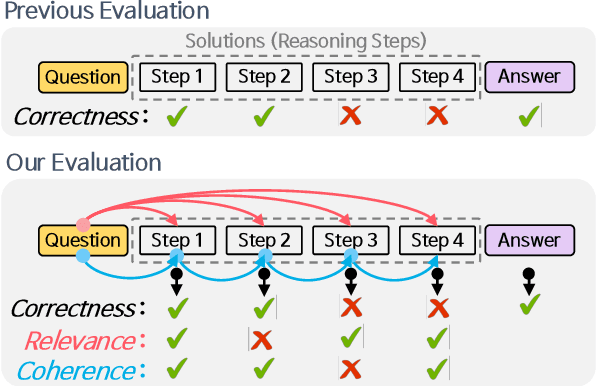
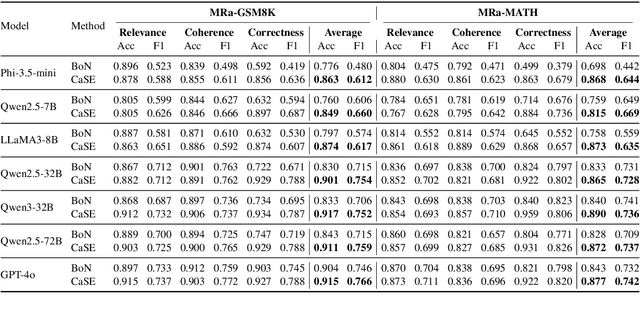
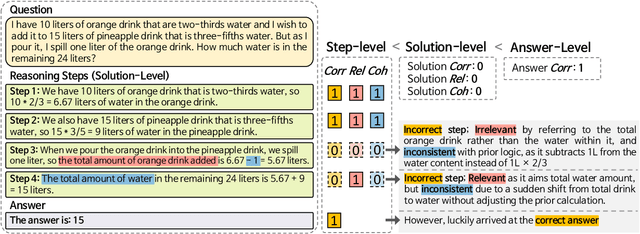
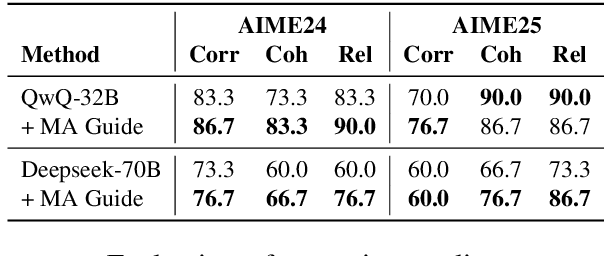
Abstract:Evaluating large language models (LLMs) on final-answer correctness is the dominant paradigm. This approach, however, provides a coarse signal for model improvement and overlooks the quality of the underlying reasoning process. We argue that a more granular evaluation of reasoning offers a more effective path to building robust models. We decompose reasoning quality into two dimensions: relevance and coherence. Relevance measures if a step is grounded in the problem; coherence measures if it follows logically from prior steps. To measure these aspects reliably, we introduce causal stepwise evaluation (CaSE). This method assesses each reasoning step using only its preceding context, which avoids hindsight bias. We validate CaSE against human judgments on our new expert-annotated benchmarks, MRa-GSM8K and MRa-MATH. More importantly, we show that curating training data with CaSE-evaluated relevance and coherence directly improves final task performance. Our work provides a scalable framework for analyzing, debugging, and improving LLM reasoning, demonstrating the practical value of moving beyond validity checks.
Dr.LLM: Dynamic Layer Routing in LLMs
Oct 14, 2025Abstract:Large Language Models (LLMs) process every token through all layers of a transformer stack, causing wasted computation on simple queries and insufficient flexibility for harder ones that need deeper reasoning. Adaptive-depth methods can improve efficiency, but prior approaches rely on costly inference-time search, architectural changes, or large-scale retraining, and in practice often degrade accuracy despite efficiency gains. We introduce Dr.LLM, Dynamic routing of Layers for LLMs, a retrofittable framework that equips pretrained models with lightweight per-layer routers deciding to skip, execute, or repeat a block. Routers are trained with explicit supervision: using Monte Carlo Tree Search (MCTS), we derive high-quality layer configurations that preserve or improve accuracy under a compute budget. Our design, windowed pooling for stable routing, focal loss with class balancing, and bottleneck MLP routers, ensures robustness under class imbalance and long sequences. On ARC (logic) and DART (math), Dr.LLM improves accuracy by up to +3.4%p while saving 5 layers per example on average. Routers generalize to out-of-domain tasks (MMLU, GSM8k, AIME, TruthfulQA, SQuADv2, GPQA, PIQA, AGIEval) with only 0.85% accuracy drop while retaining efficiency, and outperform prior routing methods by up to +7.7%p. Overall, Dr.LLM shows that explicitly supervised routers retrofit frozen LLMs for budget-aware, accuracy-driven inference without altering base weights.
ClearFairy: Capturing Creative Workflows through Decision Structuring, In-Situ Questioning, and Rationale Inference
Sep 18, 2025Abstract:Capturing professionals' decision-making in creative workflows is essential for reflection, collaboration, and knowledge sharing, yet existing methods often leave rationales incomplete and implicit decisions hidden. To address this, we present CLEAR framework that structures reasoning into cognitive decision steps-linked units of actions, artifacts, and self-explanations that make decisions traceable. Building on this framework, we introduce ClearFairy, a think-aloud AI assistant for UI design that detects weak explanations, asks lightweight clarifying questions, and infers missing rationales to ease the knowledge-sharing burden. In a study with twelve creative professionals, 85% of ClearFairy's inferred rationales were accepted, increasing strong explanations from 14% to over 83% of decision steps without adding cognitive demand. The captured steps also enhanced generative AI agents in Figma, yielding next-action predictions better aligned with professionals and producing more coherent design outcomes. For future research on human knowledge-grounded creative AI agents, we release a dataset of captured 417 decision steps.
Token Bottleneck: One Token to Remember Dynamics
Jul 09, 2025Abstract:Deriving compact and temporally aware visual representations from dynamic scenes is essential for successful execution of sequential scene understanding tasks such as visual tracking and robotic manipulation. In this paper, we introduce Token Bottleneck (ToBo), a simple yet intuitive self-supervised learning pipeline that squeezes a scene into a bottleneck token and predicts the subsequent scene using minimal patches as hints. The ToBo pipeline facilitates the learning of sequential scene representations by conservatively encoding the reference scene into a compact bottleneck token during the squeeze step. In the expansion step, we guide the model to capture temporal dynamics by predicting the target scene using the bottleneck token along with few target patches as hints. This design encourages the vision backbone to embed temporal dependencies, thereby enabling understanding of dynamic transitions across scenes. Extensive experiments in diverse sequential tasks, including video label propagation and robot manipulation in simulated environments demonstrate the superiority of ToBo over baselines. Moreover, deploying our pre-trained model on physical robots confirms its robustness and effectiveness in real-world environments. We further validate the scalability of ToBo across different model scales.
Emergence of Text Readability in Vision Language Models
Jun 24, 2025Abstract:We investigate how the ability to recognize textual content within images emerges during the training of Vision-Language Models (VLMs). Our analysis reveals a critical phenomenon: the ability to read textual information in a given image \textbf{(text readability)} emerges abruptly after substantial training iterations, in contrast to semantic content understanding which develops gradually from the early stages of training. This delayed emergence may reflect how contrastive learning tends to initially prioritize general semantic understanding, with text-specific symbolic processing developing later. Interestingly, the ability to match images with rendered text develops even slower, indicating a deeper need for semantic integration. These findings highlight the need for tailored training strategies to accelerate robust text comprehension in VLMs, laying the groundwork for future research on optimizing multimodal learning.
Leaky Thoughts: Large Reasoning Models Are Not Private Thinkers
Jun 18, 2025Abstract:We study privacy leakage in the reasoning traces of large reasoning models used as personal agents. Unlike final outputs, reasoning traces are often assumed to be internal and safe. We challenge this assumption by showing that reasoning traces frequently contain sensitive user data, which can be extracted via prompt injections or accidentally leak into outputs. Through probing and agentic evaluations, we demonstrate that test-time compute approaches, particularly increased reasoning steps, amplify such leakage. While increasing the budget of those test-time compute approaches makes models more cautious in their final answers, it also leads them to reason more verbosely and leak more in their own thinking. This reveals a core tension: reasoning improves utility but enlarges the privacy attack surface. We argue that safety efforts must extend to the model's internal thinking, not just its outputs.
Aligned Novel View Image and Geometry Synthesis via Cross-modal Attention Instillation
Jun 13, 2025Abstract:We introduce a diffusion-based framework that performs aligned novel view image and geometry generation via a warping-and-inpainting methodology. Unlike prior methods that require dense posed images or pose-embedded generative models limited to in-domain views, our method leverages off-the-shelf geometry predictors to predict partial geometries viewed from reference images, and formulates novel-view synthesis as an inpainting task for both image and geometry. To ensure accurate alignment between generated images and geometry, we propose cross-modal attention distillation, where attention maps from the image diffusion branch are injected into a parallel geometry diffusion branch during both training and inference. This multi-task approach achieves synergistic effects, facilitating geometrically robust image synthesis as well as well-defined geometry prediction. We further introduce proximity-based mesh conditioning to integrate depth and normal cues, interpolating between point cloud and filtering erroneously predicted geometry from influencing the generation process. Empirically, our method achieves high-fidelity extrapolative view synthesis on both image and geometry across a range of unseen scenes, delivers competitive reconstruction quality under interpolation settings, and produces geometrically aligned colored point clouds for comprehensive 3D completion. Project page is available at https://cvlab-kaist.github.io/MoAI.
KVzip: Query-Agnostic KV Cache Compression with Context Reconstruction
May 29, 2025Abstract:Transformer-based large language models (LLMs) cache context as key-value (KV) pairs during inference. As context length grows, KV cache sizes expand, leading to substantial memory overhead and increased attention latency. This paper introduces KVzip, a query-agnostic KV cache eviction method enabling effective reuse of compressed KV caches across diverse queries. KVzip quantifies the importance of a KV pair using the underlying LLM to reconstruct original contexts from cached KV pairs, subsequently evicting pairs with lower importance. Extensive empirical evaluations demonstrate that KVzip reduces KV cache size by 3-4$\times$ and FlashAttention decoding latency by approximately 2$\times$, with negligible performance loss in question-answering, retrieval, reasoning, and code comprehension tasks. Evaluations include various models such as LLaMA3.1-8B, Qwen2.5-14B, and Gemma3-12B, with context lengths reaching up to 170K tokens. KVzip significantly outperforms existing query-aware KV eviction methods, which suffer from performance degradation even at a 90% cache budget ratio under multi-query scenarios.
LongProLIP: A Probabilistic Vision-Language Model with Long Context Text
Mar 11, 2025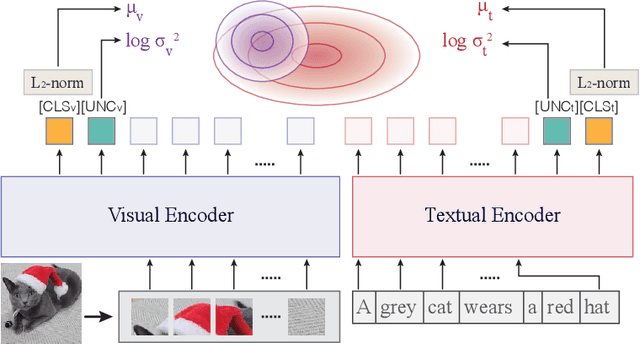



Abstract:Recently, Probabilistic Language-Image Pre-Training (ProLIP) has been proposed to tackle the multiplicity issue of vision-language (VL) tasks. Despite their success in probabilistic representation learning at a scale, the ProLIP models cannot handle long context texts longer than 64 context length, which limits their ability to capture rich contextual information from longer text sequences. To address this issue, this paper proposes a fine-tuning strategy for ProLIP to accept longer texts, e.g., 256 text tokens. Experimental results on Urban-1k and the DataComp evaluation suite show that the proposed LongProLIP recipe can improve understanding of long contexts while minimizing the negative effect of fine-tuning. We also observe a trade-off between the long context understanding (measured by Urban-1k) and general zero-shot capability (measured by ImageNet or the average of 38 zero-shot evaluation datasets by DataComp).
Code-Switching Curriculum Learning for Multilingual Transfer in LLMs
Nov 04, 2024



Abstract:Large language models (LLMs) now exhibit near human-level performance in various tasks, but their performance drops drastically after a handful of high-resource languages due to the imbalance in pre-training data. Inspired by the human process of second language acquisition, particularly code-switching (the practice of language alternation in a conversation), we propose code-switching curriculum learning (CSCL) to enhance cross-lingual transfer for LLMs. CSCL mimics the stages of human language learning by progressively training models with a curriculum consisting of 1) token-level code-switching, 2) sentence-level code-switching, and 3) monolingual corpora. Using Qwen 2 as our underlying model, we demonstrate the efficacy of the CSCL in improving language transfer to Korean, achieving significant performance gains compared to monolingual continual pre-training methods. Ablation studies reveal that both token- and sentence-level code-switching significantly enhance cross-lingual transfer and that curriculum learning amplifies these effects. We also extend our findings into various languages, including Japanese (high-resource) and Indonesian (low-resource), and using two additional models (Gemma 2 and Phi 3.5). We further show that CSCL mitigates spurious correlations between language resources and safety alignment, presenting a robust, efficient framework for more equitable language transfer in LLMs. We observe that CSCL is effective for low-resource settings where high-quality, monolingual corpora for language transfer are hardly available.
 Add to Chrome
Add to Chrome Add to Firefox
Add to Firefox Add to Edge
Add to Edge